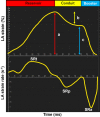Comprehensive assessment of left atrial and ventricular remodeling in paroxysmal atrial fibrillation by the cardiovascular magnetic resonance myocardial extracellular volume fraction and feature tracking strain
- PMID: 34035345
- PMCID: PMC8149643
- DOI: 10.1038/s41598-021-90117-6
Comprehensive assessment of left atrial and ventricular remodeling in paroxysmal atrial fibrillation by the cardiovascular magnetic resonance myocardial extracellular volume fraction and feature tracking strain
Abstract
Atrial fibrillation (AF) is a progressive disease that starts with structural or functional changes in the left atrium and left ventricle, and evolves from paroxysmal toward sustained forms. Early detection of structural or functional changes in the left atrium and left ventricle in the paroxysmal stage could be useful for identifying a higher risk of progression to persistent AF and future cardio-cerebrovascular events. The aim of this study was to test the hypothesis that the feature tracking (FT) left atrial (LA) strain and left ventricular (LV) extracellular volume fraction (ECV) derived from cardiovascular magnetic resonance (CMR) could detect early changes in remodeling of the left atrium and ventricle in the paroxysmal AF (PAF) stage. The participants were comprised of 106 PAF patients (age, 66.1 ± 10.7 years; 66% male) who underwent clinical CMR before pulmonary vein isolation and 20 control subjects (age, 68.3 ± 8.6 years; 55% male). The CMR-FT LA strain/phasic function and LV-ECV were compared between the PAF and control groups. The total and passive LA empty fraction (LAEF) and LA strain (corresponding to LA reservoir and conduit function) were decreased in the PAF group as compared to the control group. However, active LAEF (corresponding to the LA booster pump function) did not differ significantly between the PAF group (33.9 ± 10.9%) and control group (37.9 ± 13.3%, p = 0.15), while the active LA strain (corresponding to the LA booster pump function) was significantly decreased in the PAF group (11.4 ± 4.3 vs. 15.2 ± 5.6%, p = 0.002). The LV-ECV was significantly greater in the PAF group (28.7 ± 2.8%) than control group (26.6 ± 2.0%, p = 0.002). In the PAF group, the LV-ECV correlated significantly with the E/e' and LA volume index. Regarding the LA strain, correlations were seen between the LV-ECV and both the reservoir function and conduit function. CMR-FT LA strain in combination with the LV-ECV in a single clinical study offers a potential imaging marker that identifies LA/LV remodeling including subtle LA booster pump dysfunction undetectable by the conventional booster pump LAEF in the PAF stage.
Conflict of interest statement
The authors declare no competing interests.
Figures




Similar articles
-
Left atrial and ventricular strain and extracellular volume fraction in patients with paroxysmal and persistent atrial fibrillation.Int J Cardiovasc Imaging. 2025 Aug;41(8):1523-1533. doi: 10.1007/s10554-025-03443-5. Epub 2025 Jun 25. Int J Cardiovasc Imaging. 2025. PMID: 40560334
-
Quantification of left atrial function in patients with non-obstructive hypertrophic cardiomyopathy by cardiovascular magnetic resonance feature tracking imaging: a feasibility and reproducibility study.J Cardiovasc Magn Reson. 2020 Jan 2;22(1):1. doi: 10.1186/s12968-019-0589-5. J Cardiovasc Magn Reson. 2020. PMID: 31898543 Free PMC article.
-
Left atrium phasic impairments in paroxysmal atrial fibrillation patients assessed by cardiovascular magnetic resonance feature tracking.Sci Rep. 2022 May 9;12(1):7539. doi: 10.1038/s41598-022-11233-5. Sci Rep. 2022. PMID: 35534637 Free PMC article.
-
Left atrial strain evaluation to assess left ventricle diastolic dysfunction and heart failure with preserved ejection fraction: a guide to clinical practice : Left atrial strain and diastolic function.Int J Cardiovasc Imaging. 2023 Jun;39(6):1083-1096. doi: 10.1007/s10554-023-02816-y. Epub 2023 Feb 24. Int J Cardiovasc Imaging. 2023. PMID: 36826616 Review.
-
The Clinical Applications of Left Atrial Strain: A Comprehensive Review.Medicina (Kaunas). 2024 Apr 24;60(5):693. doi: 10.3390/medicina60050693. Medicina (Kaunas). 2024. PMID: 38792875 Free PMC article. Review.
Cited by
-
Protective effect of the Impella on the left ventricular function after acute broad anterior wall ST elevation myocardial infarctions with cardiogenic shock: cardiovascular magnetic resonance imaging strain analysis.BMC Cardiovasc Disord. 2022 Apr 28;22(1):201. doi: 10.1186/s12872-022-02632-7. BMC Cardiovasc Disord. 2022. PMID: 35484492 Free PMC article.
-
Myocardial extracellular volume fraction estimations using late enhancement CT in patients with atrial fibrillation: a comparative study with cardiac MR.Int J Cardiovasc Imaging. 2025 Mar;41(3):419-426. doi: 10.1007/s10554-024-03316-3. Epub 2025 Jan 30. Int J Cardiovasc Imaging. 2025. PMID: 39883382
-
Left atrial strain for predicting recurrence in patients with non-valvular atrial fibrillation after catheter ablation: a single-center two-dimensional speckle tracking retrospective study.BMC Cardiovasc Disord. 2022 Nov 5;22(1):468. doi: 10.1186/s12872-022-02916-y. BMC Cardiovasc Disord. 2022. PMID: 36335294 Free PMC article.
-
Variant Aldehyde Dehydrogenase 2 (ALDH2*2) as a Risk Factor for Mechanical LA Substrate Formation and Atrial Fibrillation with Modest Alcohol Consumption in Ethnic Asians.Biomolecules. 2021 Oct 21;11(11):1559. doi: 10.3390/biom11111559. Biomolecules. 2021. PMID: 34827557 Free PMC article.
-
Application of left atrial strain derived from cardiac magnetic resonance feature tracking to predict cardiovascular disease: A comprehensive review.Heliyon. 2024 Mar 9;10(7):e27911. doi: 10.1016/j.heliyon.2024.e27911. eCollection 2024 Apr 15. Heliyon. 2024. PMID: 38560271 Free PMC article. Review.
References
-
- Bellenger NG, Burgess MI, Ray SG, Lahiri A, Coats AJ, Cleland JG, et al. Comparison of left ventricular ejection fraction and volumes in heart failure by echocardiography, radionuclide ventriculography and cardiovascular magnetic resonance; are they interchangeable? Eur. Heart J. 2000;21:1387–1396. doi: 10.1053/euhj.2000.2011. - DOI - PubMed
-
- Flett AS, Hayward MP, Ashworth MT, Hansen MS, Taylor AM, Elliott PM, et al. Equilibrium contrast cardiovascular magnetic resonance for the measurement of diffuse myocardial fibrosis: Preliminary validation in humans. Circulation. 2010;122:138–144. doi: 10.1161/CIRCULATIONAHA.109.930636. - DOI - PubMed
Publication types
MeSH terms
LinkOut - more resources
Full Text Sources
Other Literature Sources
Medical

